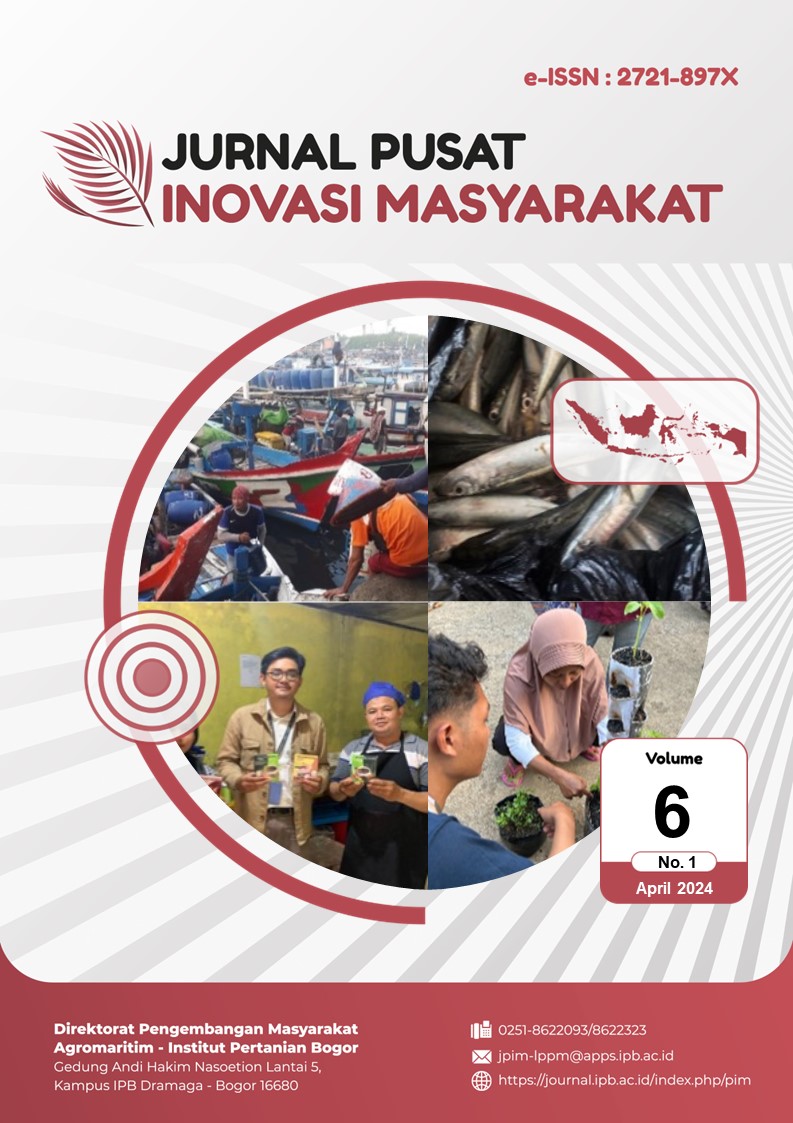Budidaya Ikan Nila pada Saluran Irigasi sebagai Pemberdayaan Masyarakat Desa Purwasari dalam Industri Perikanan
Abstract
Purwasari Village is located in the Mount Salak area and has abundant water sources with great fishery potential. This potential is further developed by creating a tilapia fish farming programme in irrigation channels in collaboration with various parties, namely the Purwasari Village government, the ‘Mekar Sari’ Farmer Group, and the RW 06 Situ Uncal community. This aquaculture programme aims to empower the people of Purwasari Village to achieve the SDGs to increase community income, reduce hunger, and poverty. The tilapia aquaculture programme consists of making three bulkheads as tilapia aquaculture ponds in the Situ Uncal irrigation canal with 200 tilapia seeds 10-15 cm long spread in these ponds and making one other bulkhead to increase the water discharge and flow in the aquaculture pond. The Tilapia aquaculture programme in the irrigation canals has received great enthusiasm from the community of Purwasari Village as a step to increase the income of the surrounding community and as a means of education for the children of Purwasari Village in the aquaculture sector. Several community groups manage the ponds, such as the RW 06 youth group, the ‘Mekar Sari’ farmer group, and the RW 06 men's group. This tilapia farming programme is a step towards community empowerment by the potential of Purwasari Village.
Downloads
References
Firdaus A. 2022. Analisis perbandingan pertumbuhan ikan nila merah (Oreocromis sp) dan nila hitam (Oreocromis niloticus). [skripsi]. Jember (ID): Universitas Jember.
Hidayat A. 2018. Potensi pembesaran ikan nila merah (Oreochromis sp.) kolam air deras di daerah irigasi Banjaran, Purwokerto, Jawa Tengah. Samakia: Jurnal Ilmu Perikanan. 9(1): 12-17. https://doi.org/10.35316/jsapi.v9i1.220
Ismail L, Yumriani, Sarwana. 2019. Analisis budidaya petani tambak terhadap kondisi sosial ekonomi di Desa Bulu Cindea Kabupaten Pangkajene dan Kepulauan. Jurnal Pendidikan Sosiologi. 7(2) : 249-256. https://doi.org/10.26618/equilibrium.v7i2.2683
Ramlah R, Soekendarsi E, Hasyim Z, Hassan MS. 2016. Perbandingan kandungan gizi ikan nila (Oreochromis niloticus) asal Danau Mawang Kabupaten Gowa dan Danau Universitas Hasanuddin Kota Makassar. BIOMA: Jurnal Biologi Makassar. 1(1): 1-5
Salsabila M, Suprapto H. 2018. Teknik pembesaran ikan nila (Oreochromis niloticus) di instalasi budidaya air tawar Pandaan, Jawa Timur. Journal of Aquaculture and Fish Health. 7(3): 118-123. https://doi.org/10.20473/jafh.v7i3.11260
[SNI] Standar Nasional Indonesia. Produksi Ikan Nila (Oreochromis niloticus Bleeker) Kelas Pembesaran di Kolam Air Tenang. Jakarta (ID): Indonesia.
Wulandari DR, Murtini S, Rudiansyah R. 2023. Analisis usaha pembesaran ikan nila (Oreochromis niloticus) pada kolam air deras di Desa Air Satan Kabupaten Musi Rawas. ESCAF. 2(1): 1387-1399.








